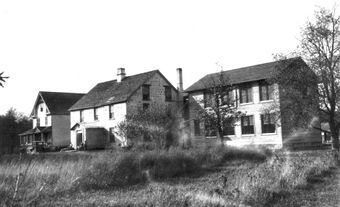Nursing
Marie Rollet Hébert [Hubou] has been credited with being the first person in what is now Canada to provide nursing care to the sick. The wife of Louis HÉBERT, a surgeon-apothecary, she arrived in Québec in 1617 and assisted her husband in caring for the sick. The first "trained nurses" to immigrate to the present site of Québec City in 1639 were members of religious orders. In fact, these nurses were not like modern nurses; they served as administrators much of the time, as doctors most of the time (making medicines and undertaking surgery), and many miracles were attributed to them.
First Hospitals
The 3 nurses were Augustinian Hospitallers whose journey was financed by the Duchesse d'Aiguillon in France (the duchess, a niece of Cardinal Richelieu, had been stirred by the reports published in JESUIT RELATIONS in France of the needs of Jesuit missionaries in New France). In 1642, in Ville-Marie [Montréal] Jeanne MANCE established a 30-bed hospital called the HÔTEL-DIEU; she was later assisted by nursing Hospitallers of St-Joseph from la Flèche.
The Sisters of Charity of the Hôpital Général of Montréal (GREY NUNS), a noncloistered order, began their work in Québec in 1737. Although these sisters, who might be considered Canada's first PUBLIC HEALTH nurses, built a hospital and an orphanage, they concentrated their work on home visits to the sick. Their free health care was funded by philanthropic gifts, but mostly through a number of entrepreneurial activities that they undertook, eg, a brewery and a freight and cartage company.
In the 18th and 19th centuries the most common health problems in Canada were the frequent EPIDEMICS of smallpox, INFLUENZA, measles, scarlet fever, typhoid, typhus and tuberculosis. Because the nursing sisters recognized the need to segregate the sick, and because much of the population was migrant and homeless, the Grey Nuns built hospitals - one (1845) in Bytown [Ottawa]. In 1844 these women canoed to uncharted areas. In 1855 they built a hospital in the RED RIVER COLONY, and they established an orphanage and a home for the aged at Lac Ste-Anne near Fort Edmonton in 1859. Later they built substantial hospitals in Fort McMurray, Alberta (1938), Fort Resolution, NWT (1939), and Fort Rae, NWT (1940).
In 1819 the 24-bed Montreal General Hospital was opened in a building on Craig Street. By 1822 it had moved to a new building and expanded to 72 beds. It was affiliated with the Montreal Medical Institution which was eventually absorbed by the medical faculty of McGill University. The early allopathic physicians tried to introduce untrained lay nurses into the hospital - an act that was unheard of in the French community, where it was believed that the sick should be nursed by sisters devoted to the service of God. The outcome was a duel (not fatal) between one of the anglophone doctors, Dr Caldwell, and a member of the legislature, Michael O'Sullivan; the result was that untrained lay nurses were hired.
In the 19th century, during the height of epidemics, the hospitals of the nursing sisters were filled to capacity, so tents and other temporary shelters had to be erected to house the sick. To alleviate some of these problems, wealthy women created benevolent societies in their communities. Assisted by municipal and provincial funds, many of these women's groups managed to construct hospitals. These hospitals were reminiscent of the institutions in England before Florence Nightingale's time - sanitary conditions were not considered important, and the care of the sick was undertaken by untrained staff who were paid in beer and shared the food and lodgings of the patients.
Other hospitals were established as moneymaking ventures by private individuals. It was in one of these hospitals, started by an entrepreneurial physician, Dr T. Mack, that the first school of nursing was established, at the General and Marine Hospital in St Catharines, Ontario, in 1874.
After several unsuccessful attempts, nursing schools based on a modification of the Nightingale system were also started at the Toronto General Hospital (1881) and Montreal General Hospital (1890). Apart from a director of nursing and perhaps a supervisor-instructor, the student nurses generally comprised the entire nursing staff of the lay hospitals. Often the students were sent out to attend private cases, but their wages were usurped by the hospitals. Graduate nurses, most of whom were not employed in these institutions, marketed their services in the community, undertaking private nursing in the homes of the more wealthy citizens.
Victorian Order of Nurses
To close the gap between the nursing care of the affluent and the poorer working people, the VICTORIAN ORDER OF NURSES (VON) was set up in 1897 by Lady ABERDEEN, the wife of the governor general. The opposition of doctors to an order of health workers who were chosen by their communities and who returned to the communities after a short training in first aid, hygiene, etc, turned this national, nonprofit organization into one that employed many professional nurses under more restricted circumstances than previously designed.
In its early years, however, the VON was largely concerned with the treatment and control of communicable diseases and with child health care. To meet an acute need for hospitals, especially in western Canada, the VON built and operated some 40 hospitals, ranging in size from 6 to 40 beds. Its nurses also administered to miners during the KLONDIKE GOLD RUSH and staffed the newly built hospital in Dawson City. After 1924, when control over the last of its hospitals had been transferred to municipal authorities, the VON concentrated on visiting nursing.
Promoted by the International Council of Nurses, an organization arising out of the women's movement in the late 19th century, the Canadian nurses, led by Mary Agnes Snively, the superintendent of nurses at the Toronto General Hospital from 1884 to 1910, established a national organization in Canada and lobbied for legislation granting nurses the status of professionals. Their aims were to ensure the quality of nursing care through improved educational programs for nurses and the licensing of graduates to protect the title of nurse. In 1907 the Canadian National Association of Nurses, the precursor to the present Canadian Nurses' Association (CNA), was formed; in 1908 it joined the international body. In 1916 it founded its national monthly magazine publication, The Canadian Nurse.
Securing legislation for nurses was not easy. Legally, women had the same status as imbeciles and children, and many members of Parliament did not feel that women were capable of managing such worldly affairs. The schools of nursing and the hospitals were run by male doctors and administrators who did not wish to relinquish their control over the nursing programs to the professional nurses. Even after nurses' Acts had been passed in all provinces (the first in Nova Scotia in 1910) changes in the nursing curriculum were not easily introduced.
Education
The first university degree program for nurses, initiated at UBC in 1919, was for a long time the only one in Canada. In a 1932 report on nursing education across Canada, Dr G. Weir found that between 1913 and 1930 there had been a sevenfold increase in the number of hospital-nursing schools, but that these did not provide the quality of education necessary for highly competent nurses. The 220 training schools turned out a disciplined work force largely used to make hospitals attractive for patients. The money charged the patients was not paid to the student nurses for their labour but invested in expanding the physical plant. The working day of a typical nurse was between 12 and 20 hours, with one day (or one half-day) free weekly. The schools themselves were mostly primitive and cramped. In response to this situation the Canadian Nurses' Association and the Canadian RED CROSS SOCIETY (which founded the Metropolitan Demonstration School of Nursing in Windsor, Ontario, in 1946) initiated a nursing education program, independent of hospital control, to prove that, if it controlled the curriculum, a school of nursing could train skilled clinical nurses in only 2 years.
Another report, issued under the auspices of the Pilot Project for the Evaluation of Schools in Canada in 1960, recommended that the CNA undertake a study of nursing education in Canada; that a national school improvement program be implemented; and that a national evaluation of nursing service programs be undertaken. Within 10 years, in all but the Atlantic provinces, nursing education was to be carried out within the educational system. Nursing programs are conducted at universities and community colleges. The Bachelor of Science-Nursing (BScN) degree is a 4-year program, which may be supplemented by post-degree certificate programs in specialized areas of study (eg, critical care, neonatal, nephrology nursing). Many universities also offer a Master of Nursing (MN) degree. In 1991, the first Canadian PhD in a nursing program was instituted at the University of Alberta.
Because the primary aim of the hospital schools of nursing had been to supply the institutions with cheap labour, little importance had been paid to the educational programs and none to the community's demand for private-duty nursing. The continual supply of graduates resulted in a high unemployment rate that was exacerbated by the GREAT DEPRESSION. During the 1930s very few people could afford a private nurse. The governments at the time responded by providing funds so that the sick could be sent to hospitals and graduate nurses could be hired to care for them. But high unemployment and poor wages plagued the profession until WWII, when many nurses joined the armed forces as officers. Nevertheless, many women were still attracted to nursing because it was one of the few "respectable" occupations open to them.
The military recruitment of the nurses resulted in a shortage in Canada that was filled by older women returning to the profession they had been forced to leave when they married. Because of demands of homes and families, hospital authorities could no longer require nurses to live within hospital premises and many single women also took this opportunity to move out of nurses' residences. In the community the nurses found their living costs to be higher than their salaries, and they began to demand higher wages. Married nurses also argued for shorter hours to enable them to manage their home responsibilities. Legislation had granted nurses professional status and had given them rights and some power over educational curriculum, but it had not given them the power to improve their wages or working conditions. Thus, they turned to unionization.
Professionalization
The first group of nurses to negotiate an employment contract in 1939 did so through a professional organization formed by a nursing sister in Québec City. In 1945 the BC nurses' professional association became the first to assist nurses in becoming unionized province wide. It was not until 20 years later that nurses in the rest of the country followed suit. In 1973 the Saskatchewan Supreme Court ruled that the professional association in that province could no longer involve itself in union activities. As a result the collective bargaining arm of the association split off and became a full-fledged nurses' union. Similar separations occurred in other provinces as well; by 1980 all of the medical nurses had 2 provincial organizations to represent their interests - a professional body and a nurses' union.
In 1981 the 3 nurses' federations (unions) in Québec joined together to form a bargaining cartel called the Fédération d'infirmières et infirmiers du Québec. That same year the nurses' unions in most provinces other than Québec joined to form the National Federation of Nurses' Unions. At the national level the nurses' interests were then represented by the union and by the professional body, the Canadian Nurses' Association.
Psychiatric Nursing
The history of psychiatric nursing is separate from that of medical nursing but follows a similar pattern. The first psychiatric nurses were the French religious sisters who in 1714 established a 12-bed ward in the hospital in Québec City. The forerunners to the contemporary psychiatric nurses were employed as custodial workers in the new asylum in Brandon, Manitoba. In 1921 regular training programs for nurses were organized in this hospital. Other training programs were soon established in the psychiatric hospitals in the other 3 western provinces.
In contrast to the medical nurses, psychiatric nurses were unionized with the rest of the public service beginning in the 1940s, but they soon felt the need for control of their own profession. The movement for professionalization of psychiatric nurses began in Saskatchewan in 1948. The BC psychiatric nurses gained recognition as recently as 1968. A few years prior to this, the precursor to the Psychiatric Nurses' Association of Canada had been formed. In 1961 the Canadian Journal of Psychiatric Nursing succeeded an earlier publication devoted to issues in the profession.
Registered Psychiatric Nurse (RPN) is a separate degree from the BScN. The degree program follows the BScN program for the first 2 years, then follows a distinct course of study for the final 2 years.
Public Health
In 1919 a federal department of health was founded in response to the influenza epidemic, and provincial departments of health began to replace provincial health boards. Provincial public-health nursing services were developed, beginning in Manitoba in 1916, to assist with municipal immunization and child health-protection programs. The federal health department, which was replaced in 1944 by the Department of National Health and Welfare (now HEALTH CANADA), is now responsible for all federal matters relating to the promotion and preservation of health, social security, emergency health services, and for the provision of health, medical and hospital services for First Nations, Inuit and the general population of the 2 territories, etc (seeNATIVE PEOPLE, HEALTH). Since 1945, nursing positions have been established to advise the department, provide consultative services to the provinces and direct services to certain segments of the population. The Medical Services Branch of Health and Welfare also provides direct nursing services to a small segment of the population, ie, First Nations, Inuit and other residents of the territories. The branch administers and staffs the outpost nursing stations and health services where registered professional nurses function as general practitioners.
See alsoNURSING SISTERS.

 Share on Facebook
Share on Facebook Share on X
Share on X Share by Email
Share by Email Share on Google Classroom
Share on Google Classroom






